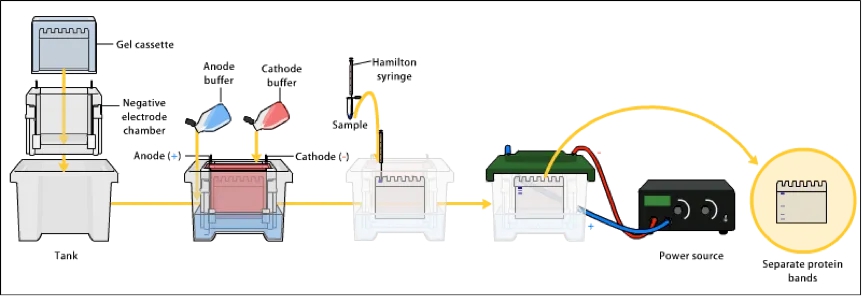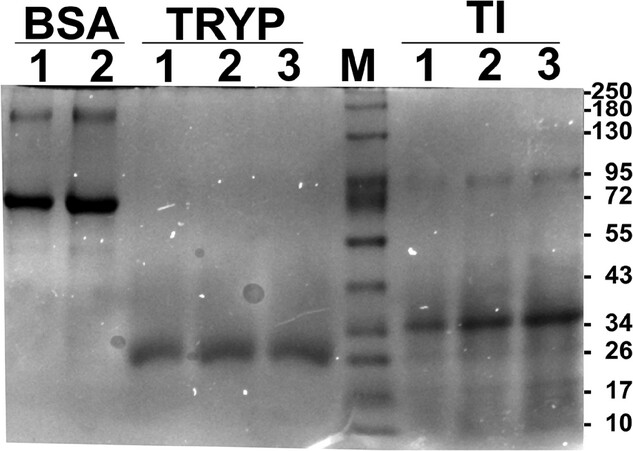SDS-PAGE Analysis Service
- Protein denaturation and charge uniformity: SDS linearizes proteins by disrupting non-covalent bonds and binds them in proportion to size, ensuring migration speed depends solely on molecular weight.
- Gel-based separation: Polyacrylamide gels act as molecular sieves, with adjustable acrylamide concentrations targeting specific molecular weight ranges. Stacking gels concentrate protein bands, while resolving gels achieve high-resolution separation.
- Electrophoresis and staining: Proteins migrate towards the positive electrode, with smaller proteins moving faster. After staining with Coomassie blue or silver, molecular weight and purity are evaluated by comparing with standards.
- Protein molecular weight estimation for validating expression accuracy.
- Sample purity evaluation in purified proteins.
- PTM analysis, such as phosphorylation and glycosylation detection.
- Preliminary analysis of recombinant protein expression.
- Characterizing protein components in complex samples.
SDS-PAGE analysis utilizes sodium dodecyl sulfate-polyacrylamide gel electrophoresis (SDS-PAGE) to separate and analyze proteins based on molecular weight. This high-resolution separation method, performed under denaturing conditions, is widely employed for protein purity evaluation, molecular weight determination, and post-translational modification (PTM) studies.
MtoZ Biolabs offers comprehensive SDS-PAGE analysis service supported by advanced experimental platforms and extensive technical expertise. Our services span the entire workflow, from sample preparation to image analysis, and are tailored to meet diverse client needs. By delivering accurate and reliable protein analyses, MtoZ Biolabs empowers researchers to uncover protein characteristics with precision, providing robust support for life science research and innovation.
Technical Principles
SDS-PAGE analysis operates by denaturing proteins and imparting a uniform negative charge using sodium dodecyl sulfate (SDS), enabling separation based on molecular weight:

Figure 1. Workflow for SDS-PAGE
Technical Advantages
MtoZ Biolabs integrates advanced equipment and optimized protocols to enhance SDS-PAGE analysis capabilities:
1. Precise Protein Separation: Separates proteins ranging from 5–250 kDa with exceptional clarity.
2. Customizable Gel Options: Offers fixed-concentration and gradient gels for diverse experimental needs.
3. Comprehensive Downstream Analyses: Supports multiple staining methods and protein transfer for subsequent validation.
4. High Sensitivity and Clarity: Optimized staining ensures clear visualization, even for low-abundance proteins.
5. Quantitative Insights: Detailed analysis through specialized software provides robust band data.
Analysis Workflow
Our SDS-PAGE analysis service is designed to provide a reliable and systematic approach for separating and analyzing proteins. By optimizing every step of the workflow, we ensure accurate molecular weight determination and protein characterization, tailored to meet diverse research needs. Below is an overview of our detailed analysis process:
1. Sample Preparation: Ensures suitability through concentration, buffering, and pretreatment.
2. Gel Preparation: Tailors polyacrylamide gel concentration to target molecular weight.
3. Electrophoresis: Standardized voltage and time conditions enable precise separation.
4. Staining or Transfer: Offers staining options and PVDF membrane transfer for further analysis.
5. Image Analysis: High-resolution imaging and software-assisted quantification deliver accurate results.
Why Choose MtoZ Biolabs?
1. Advance Analysis Platform: MtoZ Biolabs established an advanced SDS-PAGE analysis platform, guaranteeing reliable, fast, and highly accurate analysis service.
2. One-Time-Charge: Our pricing is transparent, no hidden fees or additional costs.
3. High-Data-Quality: Deep data coverage with strict data quality control. AI-powered bioinformatics platform integrate all SDS-PAGE analysis data, providing clients with a comprehensive data report.
4. Customized Service: Tailored to the specific research needs of our clients, we offer flexible experimental design and personalized data analysis to ensure the achievement of research goals to the fullest extent.
Applications
The SDS-PAGE analysis service offered by MtoZ Biolabs provides versatile solutions for protein separation and characterization across various research fields. By leveraging this powerful technique, researchers can efficiently analyze protein properties, ensuring reliable results for downstream applications. Below are some of the key applications of our service:
Case Study
Case1
SDS-PAGE analysis was employed to assess residual proteins in BM-MSC products during clinical production, ensuring their purity and supporting quality control efforts.

Kilic, P. et al. Electrophoresis. 2024.
FAQ
Q1: Why do bands in SDS-PAGE analysis appear smeared rather than clearly defined?
Smearing can result from sample overloading, incomplete denaturation, or inconsistent electrophoresis conditions. MtoZ Biolabs recommends optimizing protein sample loading to avoid overloading, which may compromise resolution. Complete denaturation with SDS and reducing agents (e.g., β-mercaptoethanol or DTT) ensures protein aggregation is minimized. Our standardized gel preparation and electrophoresis protocols rigorously control buffer composition, gel concentration, and electric field conditions, delivering optimal, clear protein bands.
Q2: What types of samples are suitable for SDS-PAGE analysis?
SDS-PAGE analysis accommodates a wide range of protein samples, including cell lysates, recombinant proteins, tissue homogenates, and serum. Whether for basic protein quality control or targeted analyses of purity and molecular weight, SDS-PAGE analysis offers effective solutions. For complex samples, MtoZ Biolabs provides pretreatment and concentration services to ensure experimental accuracy and reliability.
Q3: How does SDS-PAGE evaluate protein purity?
SDS-PAGE separates proteins by molecular weight, enabling assessment of purity based on the number and intensity of bands. Highly pure samples typically yield a single, distinct band, while less pure samples may exhibit multiple or diffuse bands. High-sensitivity staining methods, such as silver staining or fluorescent staining, enhance detection of low-abundance impurities, facilitating comprehensive purity evaluation.
MtoZ Biolabs, an integrated Chromatography and Mass Spectrometry (MS) Services Provider, provides advanced proteomics, metabolomics, and biopharmaceutical analysis services to researchers in biochemistry, biotechnology, and biopharmaceutical fields. Our ultimate aim is to provide more rapid, high-throughput, and cost-effective analysis, with exceptional data quality and minimal sample consumption. Free project evaluation, welcome to learn more details!
MtoZ Biolabs, an integrated chromatography and mass spectrometry (MS) services provider.
Related Services
How to order?







